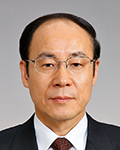Messages from Keidanren Executives and Contributed articles to Keidanren Journals September, 2016 Preparing Our Human Resources for the Future

The wave of globalization in business activity continues to gain momentum, while revolutionary advances in technology in fields such as IoT (Internet of Things), robotics, and artificial intelligence are leading us toward a super-smart society as seen in the "Society 5.0" concept. These developments can be expected to bring dramatic changes both to society and to the structure of industry. According to one startling forecast, as of 2030, when the children who enter elementary school next spring will have completed their education and be seeking employment, around half of today's jobs will no longer be in existence.
In the face of this prospect of radical change, Keidanren has noted some of the attributes and skills that future job seekers will require. One is the ability to identify issues based on their own awareness and seek solutions through their own initiative. They should also have a broad grounding in the liberal arts, along with foreign-language communication skills, and knowledge encompassing both the humanities and sciences. They will need to respect diversity. And they will require the ability to tap information productively, putting it to work for the solution of problems.
Acquiring this full set of attributes and skills will be no easy matter, however. On a broader level, our goal should be to create a society of people who can act as independent individuals, who recognize their own distinctive features and strengths, who accept the differences between themselves others, and who can collaborate with others in creating new value. Independence, collaboration, and creation—these will continue to be core concepts for the development of human resources in the years and decades to come, even as the flow of change rushes forward. And what are the perspectives we should adopt as we consider where we want the process of creation to lead? In Keidanren's vision for 2030, "Toward the Creation of a More Affluent and Vibrant Japan," we have set forth innovation—in technology, in society, and in systems—and globalization as the key words guiding our path toward the future.
At the same time, we must be on guard against the potentially adverse effects of schooling that concentrates solely on developing top-level human resources to cope with change and other challenges. It is important, we also believe, to create a strong "safety net" within the educational system.
Leading companies have recognized that the foundation for sustained growth lies in respect for diversity and mutual inclusion, and they have positioned the promotion of diversity and inclusion as pillars of their human resource development programs. Through their management policies and initiatives, including coordination and cooperation with the academic world, it is the mission of corporate executives and of the business community to promote the use of people with a variety of individual traits and capabilities so as to assemble the best possible groups to build the future.

